Menus
- The Cafe Racer spirit and the joys of the single-cylinder combined in one motorcycle
- Single cylinder, 535 cm3, 29.1 hp at 5,100 rpm, 44 Nm at 4,000 rpm, 192 kilos, 6,295 euros
- Discovery
- In the saddle
- Engine and transmission
- In the city
- On motorways and main roads
- On departmental
- Part-cycle
- Brakes
- Comfort and duo
- Consumption & autonomy
- Conclusion
The Cafe Racer spirit and the joys of the single-cylinder combined in one motorcycle
Single cylinder, 535 cm3, 29.1 hp at 5,100 rpm, 44 Nm at 4,000 rpm, 192 kilos, 6,295 euros
The venerable and more than a hundred-year-old Royal Enfield has cleverly delved into its past when it came to developing its range around the essential Bullet.. Indeed, this machine is a tribute to the Continental GT of 1965, whose small 248 cm3 single-cylinder produced 21 horsepower, which made it one of the most powerful 250 of its time. Well helped by its small racy look, its rear controls, its handlebars bracelets and its 5-speed gearbox, it was a nice little commercial success at the time..
In the name, the color, the shape of the tank and the general spirit, this Continental GT 535 pays homage to it. Oh, she does not share all the points in common: she is not the fastest 500 of her time, it would even be the opposite. It doesn’t matter, because the Continental GT (besides a surname it shares with Bentley, it’s surprising – and all the better – that the winged B brand has not locked the name) capitalizes on three things: a nice little look cafe racer, a historic brand and an engine derived from that of the Bullet, without major modifications. Is it enough for the cocktail to take ?
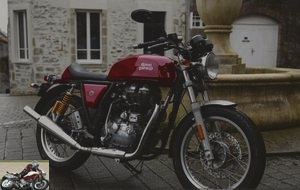
Discovery
The Continental GT has the great merit of making us rediscover the joys of simplicity and of showing us that in this grotesque and bloated world, desire can emerge from a minimalism that borders on asceticism. Indeed, what is superfluous in this machine? Not much ; or nothing at all in fact, if we assume that a tachometer is essential given the "sporting" provisions of the machine. Yes, we put quotes.
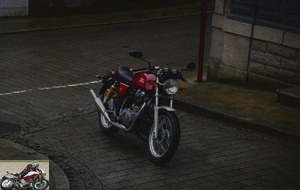
Between the thin tank and the sides sculpted in the rear part, the small saddle surrounded by its plump little backsplash, the mechanical parts reduced to their simplest expression (an air-cooled single cylinder, an exhaust, what more?), Small spoked wheels, the Continental GT plays the card of simplicity. We see it thin, we dream it slender, we imagine it light: yet it weighs 192 kilos, but the abuse of "Bullet" counts less than the others because there are probably twenty kilos in the crankshaft and all the weight is downstairs. So we don’t feel them.
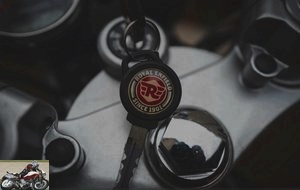
The Continental GT has this other virtue of having a simple design that borders on timelessness: we do not know if it is modern or if it should relate to the 60s or 70s. And it does not matter, in fact, because what matters is that tomorrow, it will not be out of fashion. For a simple reason: fashion, she doesn’t care, otherwise Royal Enfield would have come out in matt gray waxed concrete with neon yellow rims and a super nasty LED light, all with a lot of cleverly crafted marketing discourse. . None of that: the Continental GT is a bike that can’t be told and seems to stand on its own.
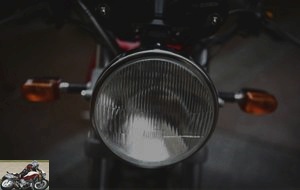
Another strong point of this bike: it easily bends to all transformations. As an example, but there are others, here is what makes it one of the Concept Store of the brand in France, Tendance Roadster. Not bad is not it ?
In the saddle
In addition to a saddle reasonably positioned at 810 mm, it is the great narrowness of the saddle and the tank at the crotch that makes its grip extremely easy. This is no small argument, because we realize that small riders feel at ease on the handlebars of this bike; and, surprise, the big ones too, thanks to a well-studied driving position, with half-handlebars tilted slightly forward for a sporty feeling, but without excess.

In front of you, speedometer and tachometer in two round boxes, old-fashioned, with a small digital window (two trips and fuel gauge). And that’s all. Here again, modesty is on the program: counter graduated up to 160 km / h and tachometer whose red zone starts at 5500 rpm, it immediately puts you in the mood. If ABS is on the program of the latest models conforming to Euro-4, obviously do not expect engine mapping, anti-slip or other frills. What next ?
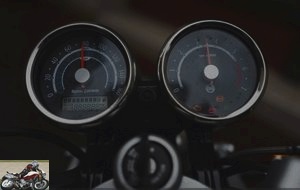
Engine and transmission
Unsurprisingly, the base is that of the Bullet EFI: the long stroke and tumbled single cylinder saw its displacement go from 499 to 535 cm3 by an increase in the bore (from 84 to 87 mm), the stroke being still at 90 mm. The increase in displacement is modest (it was surely to mark the occasion) and the gain in power is just as much: indeed, rest your comb on the dresser because you will not need to re-style your hair afterwards, that "climbs" from 27.2 horsepower at 5250 rpm to 29.1 horsepower at 5100 rpm (the power is so modest that Royal Enfield takes care to indicate the decimals!). As for the couple, it makes a prodigious leap from 41.3 to 44 Nm, always obtained at 4000 rpm. The whole goes to the wheel by a box 5.
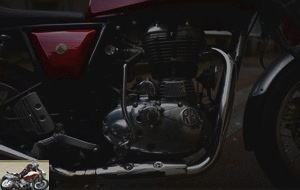
Either way, whoever remains attached to these numbers has failed to understand the Royal Enfield spirit. Because beyond the technical sheet, there are the sensations and the pleasure that one feels to ride on small roads…
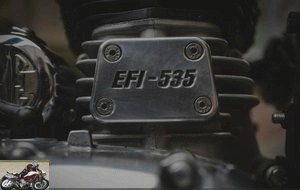
In the city
Despite its "cafe racer" posture, the Royal Enfield Continental GT remains very popular in town: the proof with a good turning radius and this driving position, not too much pressure on the front, which helps to maneuver. We also note the good balance of the bike, which allows you to make U-turns with the steering at the stop, without having to put your feet on the ground. Like what, lightness and ease are the two breasts of urbanity.

For a large single-cylinder, the engine is really flexible and that too is another excellent asset to make this machine an excellent everyday companion. Basically, we can drive in third under 2000 rpm without the single cylinder pounding in its jacket, while at 50 km / h, in fourth, we hold a small 2100 rpm on a trickle of gas, without that the hindquarters do not protest nor that the mirrors vibrate too much. So, apart from the question of the lock (even if the Continental GT is not in the top 10 of the most stolen motorcycles), we have only good things to say to you. !
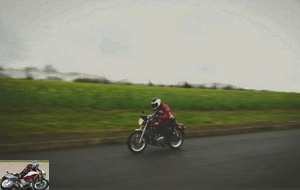
On motorways and main roads
If you really want to be flashed, then we recommend the latest Kawasaki H2 SX SE. Otherwise, the Continental GT is certainly a very good choice. By its old school design, the tumbled single cylinder does not like high revs. Basically, he is really reluctant and despite his red zone at 5500 rpm, to exceed 4500 rpm. Suddenly, at this speed, we are a little above 120 km / h, but in fact, to limit the vibrations and not to put the mechanics under tension for too long, we would like to advise you a speed of cruise of the order of 100/110 km / h, i.e. around 4000 rpm. The slightly tilted position helps to fight against the wind, the chassis does not sway and only the saddle, a little firm, seems rough in the long run..
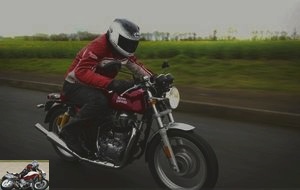
On departmental
If the remark is obviously valid for all motorcycles, this is obviously where the Continental GT is in its element. She blushes with pleasure, the little one. Obviously, we suspect that the performances will not be breathtaking anyway. At 90 km / h on the last report, the mono turns at 3200 rpm and on the handlebars, we appreciate the ride. And no matter the next 80 km / h limit, the mono is flexible enough to stay in fifth at this snail pace (but that’s for your safety).

Here, the pleasure comes from the lightness of the motorcycle, due to the absence of filters to the conduct between what you want and what you feel. We saw the pulsations of the single-cylinder, we felt it towing, generously giving its 44 Nm. The Continental GT nevertheless requires a small world of employment. Know how to aim between 2500 and 4000 rpm and you will get all the substance; above, it vibrates seriously and the engine reveals all its inertia. And the Cafe Racer side in it all ?
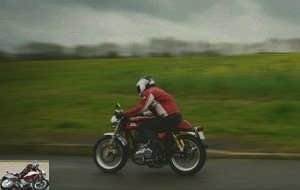
Let’s say that it remains above all subjective. Of course, compared to a Bullet, we have a driving position that allows you to be a little more forward, to better feel things on the handlebars, to become better at one with the machine. We can therefore have a little more precise driving. But from "precise" to "playful", there is a step that we will not take: first, because with the modest power and the inertia of the single cylinder, we never really arrive in "catamaran" mode, standing on the brakes "when cornering. We wind, we respect the range of use. Then, because if the frame is rigid and allows good driving precision, the whole is a little spoiled by the rear shocks which, life being a question of permanent negotiation, would have seduced us if they had reconciled their stiffness with rigor. But this is not the case: that it beats, certainly, but that it moves, blah. Finally, the tires are simply bad: the Pirelli Sport Demons are to be thrown away immediately. They weigh down the bike, offer no feeling and are not zealous in terms of grip. Already, in the dry, it’s not terrible, so in the wet, beware.
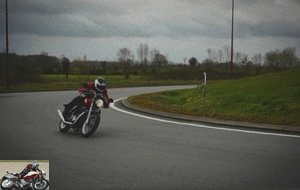
Nothing dramatic, however: tires, it changes, shock absorbers too and we know that no 6000 motorcycle offers a cycle part of 250 GP. But hey, if you want to get the most out of your Continental GT, you know what you have to do..
Part-cycle
Nothing to do here with the frame of the Bullet: the Continental GT has in particular a double lower cradle and not a simple one, as on the other 500. The frame was designed by the specialized British firm Harris Performance, which was then bought by Royal Enfield. The 41 mm diameter fork debates over 110 mm (130 mm on the Classic) and the double shock absorber with separate gas cylinder debates over 80 mm, in addition to being adjustable in preload.
The tires are Pirelli Sport Demon in 100/90 x 18 at the front and 130/70 x 18 at the rear, fitted on wire wheels.
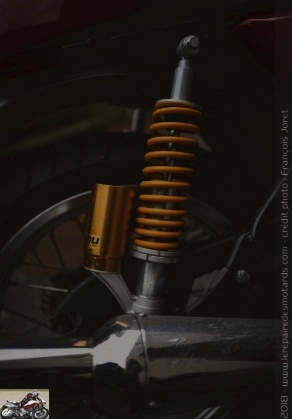
Brakes
The device is designed by Brembo, with a single 300mm disc clamped by a 2-piston caliper at the front, aided by a 240mm disc and a single-piston caliper at the rear. ABS is obviously present on Euro 4 models. At the front, the power is there but you still have to tap the lever; we console ourselves with a very progressive bite, which will appeal to young drivers arriving on this bike. At the rear, the power is there and the ABS is not too intrusive; we even tend to think that it manifests itself almost too late, because it is possible to briefly block the wheel on the large brake ports.
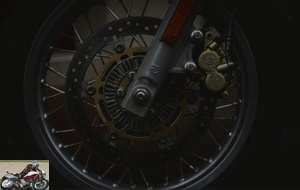
Comfort and duo
If it was delivered as a two-seater version at the start, the Continental GT was quickly approved only as a single-seater version. Suddenly, to nab a Geraldine, you will have to leave her his 07 (06 is an old thing!) And manage the case later. As far as you are concerned, this is correct, but not free from flaws. The riding position allows the bollards to be cleared without feeling very tired, but the saddle ends up being very flat and a little hard in the long run, while the rear shocks do their job without grace. We console ourselves with the fork that does not heel. On the other hand, at stabilized speed, we see vibrations of the handlebars, more than on a Bullet.

Consumption & autonomy
A Continental GT knows perfectly well how to stay under the 4 liters / 100 mark, which with the 13.2 liters of gasoline, allows more than 300 kilometers of autonomy and after that, you will be happy to see it arrive, the break. A fuel gauge in the small digital window and two trips (there are none on the Bullet and Classic) should allow you to avoid running out of fuel..
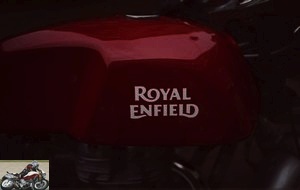
Conclusion
Bad news: the production of Continental GT 535 ceased at the beginning of the year in India. It will be replaced by the Continental GT 650, the chassis of which will largely take over the designs of the single-cylinder. Let’s just hope that the Pirelli Sport Demons will finally be replaced with decent wraps and the shocks will be a little less stiff while being a little more rigorous..
Good news: there is still stock at dealerships and the used market is open to you. The opportunity, it is the case to say it, to dive into an important part of the history of motorcycling, that of the single cylinder with sporty performances, which structured the entire English ecosystem at the turn of the 1950s and 1960s. If the Continental GT’s "cafe racer" performance remains a little cerebral, the bike is nonetheless terribly endearing. We can therefore take the plunge without fear, so the Continental GT is an excellent daily companion while being an endearing mount as soon as we go green … provided we have time to live. Which is a real luxury today !
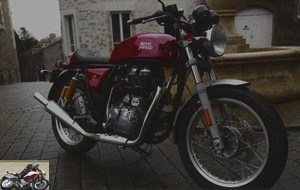
Strong points
- Historic make and model
- Lightness
- Handling
- Torque motor
- Old-fashioned single-cylinder fun
- A2 license compatible, necessarily
Weak points
- Really poor tires
- Stiff rear shock absorbers and without rigor
- Some vibrations in the handlebars
- Saddle a little firm
The technical sheet of the Royal Enfield Continental GT
Test conditions
- Itinerary: 130 km and a short day of testing in the Poitou countryside during the One Ride.
- Motorcycle mileage: 150 km
- Problem encountered: none
The competition: Honda GB 500 in import, Yamaha SRX 600 used, otherwise, not much !
Related articles
-
Single cylinder, 411 cc, 24.5 hp at 6,500 rpm, 32 Nm at 4,000 rpm, 185 kilos, from € 4,495 A small, economical and versatile single-cylinder trail runner…
-
Royal Enfield Classic Euro 4 test
4-T single cylinder, 499 cm3, 27.2 hp at 5,250 rpm, 41.3 Nm at 4,000 rpm, 195 kilos, € 5,985 A timeless machine with inimitable charm Welcome to the…
-
Royal Enfield Meteor 350 motorcycle test
Entry-level, extra class Air / oil single cylinder, 349 cm3, 20 hp and 27 Nm, 191 kg full made, from 4.099 euros Royal Enfield commemorates its 120th…
-
Royal Enfield 650 Interceptor and Continental GT test
Authentic (r) evolution Twin-cylinder in-line, 648 cm3, 47 hp and 52 Nm, 198 kg dry, double tubular cradle frame At the end of 2018, Santa Claus is…
-
Single cylinder tumbled, 499 cm3, 27 hp, 41 N.m, 187 kilos with full tank, € 5,785 A retro machine full of charm to rediscover the joys of everyday life…
-
Royal Enfield Bullet Standard Test
The time machine Born in Great Britain in the 1890s (and the offshoot of a weapons factory, hence the name of its models, Bullet), but Indian since the…
-
Royal Enfield Bullet 500 motorcycle test
Indian classic Virtually unchanged in 50 years, the Royal Enfield Bullet is the epitome of the motorcycle in its simplest form: two wheels, handlebars…
-
Royal Enfiel RE350 Brass Rajah motorcycle test
The Indian Bobber King of Brass 346 cc single cylinder, 19.8 hp, 28 Nm, 155 kg dry The customization of motorcycles has known for a decade a continuous…
-
A test on the road, in the paths and especially in the mud of the Conti off / road enduro tire Original equipment from the BMW R1200 GS Adventure, the F…
-
A new entrant noticed in the niche of fun and stylish roadsters Single cylinder, 692 cm3, 75 hp at 8,500 rpm, 72 Nm at 6,750 rpm, 157 kilos dry, € 10,290…